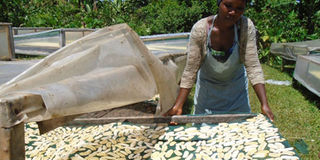Solar dryer eases farm work

Sarah Auma spreads banana chips inside a solar dryer at her farm in Kayuna. Photo by Fred Muzaale
What you need to know:
The solar dryer is a small structure made of timber, wire mesh to hold the produce and greenhouse plastic sheet. The dryer purely relies on green energy as it uses solar or wind, writes Fred Muzaale.
A sharp aroma from the drying pineapples placed in solar driers covers the entire compound of Patience Pays Initiative (PPI) in Ndeeba village, Kayunga Town council, Kayunga District.
PPI is a local company involved in drying fruits and vegetables for both local and export markets. It is also involved in the manufacture of solar driers for sale.
Jane Naluwayiro, the proprietor of PPI says using a solar dryer to dry pineapples, paw paws, jack fruits and apple bananas makes the process of drying faster.
“It is warmer inside than outside so the produce will dry faster than when it is put in open-air sun to dry. This solar dryer has brought joy to me and many other farmers in this district,” she says as she picks up a plastic container full of sliced bananas and takes them to the dryer.
She adds: “Besides, there is less risk of spoilage because of the high speed of drying and the substance is also protected from contamination,” she says.
It takes only two days for the substance to dry instead of the four or five.
What is a solar dryer?
Solar driers are devices that use solar energy to dry substances especially food.
In Uganda they are used to add value to fruits through drying.
The dryer is triangular and measures 13 feet by 10 feet. It is covered in ultraviolet polythene, which lets in light.
Inside are rows of wooden trays whose base is a special black web mesh, which Naluwayiro says helps to absorb heat and speed up the drying process.
She demonstrates by pulling out an empty tray on the second row and arranges the sliced bananas neatly in it, ensuring she leaves enough space between the slices.
She does the same on other trays until the basin is empty.
“This is a special web mesh. It absorbs and retains heat. An increase in heat causes the bananas to dry fast,” says Naluwayiro.
Types of solar driers
Abbas Were, another farmer involved in fruit drying in Kangulumira Town, Kayunga District says there are different types of solar driers.
However, he says, the most commonly used in Uganda is the static- bed-box- type solar drier and hybrid solar tunnel solar dryer.
1. The static –bed-box solar drier is manufactured using timber-framed cabinets covered in plastic sheet.
The cabinet is raised off the ground using wooden legs, which rest on stones for stability and to reduce insect attack.
Air enters through a mesh vent in the base of the drier and exits through vents at the top of the back or sides.
The upper surface of the polythene slopes up slightly from the front to the back, in order to direct the airflow.
When sunlight falls on the drier the air inside heats up to a temperature of 50°C or more, and water evaporates from the fruit.
The warm air expands and escapes through the top vents, taking water with it, and it is replaced with cooler, drier air drawn in through the bottom vents.
This type ( Static bed solar drier), Were says, is not durable as some parts like the wooden timber cabinet frame can over time get ruined due to the high heat.
The polythene sheet too, gets worn out after about a year due to the much heat inside the drier. However, the polythene can be replaced.
Cost
Naluwayiro says this type goes for between Shs700,000 and Shs800,000, depending on its size.
However, she says one that can dry between four to five kilogrammes of fruit costs Shs800,000.




